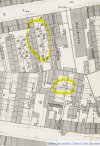A quick question from one unfamiliar with the back to back layout but fascinated to learn more of my family history in Birmingham... the maps i have form the era I'm looking at (1900-30) don't give me much indication as to whether the back to backs on Latimer Street and Irving Street were entirely walled off from one another, or whether there were small walkways or access ways to walk through from one street to another, could anyone help?
The very specific example is an address at 7/23 aka 7 court 5 (Highbury Place I believe) Latimer Street, and 6 The Limes Irving Street which I believe was 159 or 160. They almost back on to one another so I'm trying to understand if people passed between the courts through literal 'back channels' or whether the route to get between these courts would be on foot right back via what looks like a large crossroads with Cregoe Street.
Any thoughts from anyone familiar with the set up at this time?
Thank you very much in advance!
The very specific example is an address at 7/23 aka 7 court 5 (Highbury Place I believe) Latimer Street, and 6 The Limes Irving Street which I believe was 159 or 160. They almost back on to one another so I'm trying to understand if people passed between the courts through literal 'back channels' or whether the route to get between these courts would be on foot right back via what looks like a large crossroads with Cregoe Street.
Any thoughts from anyone familiar with the set up at this time?
Thank you very much in advance!




